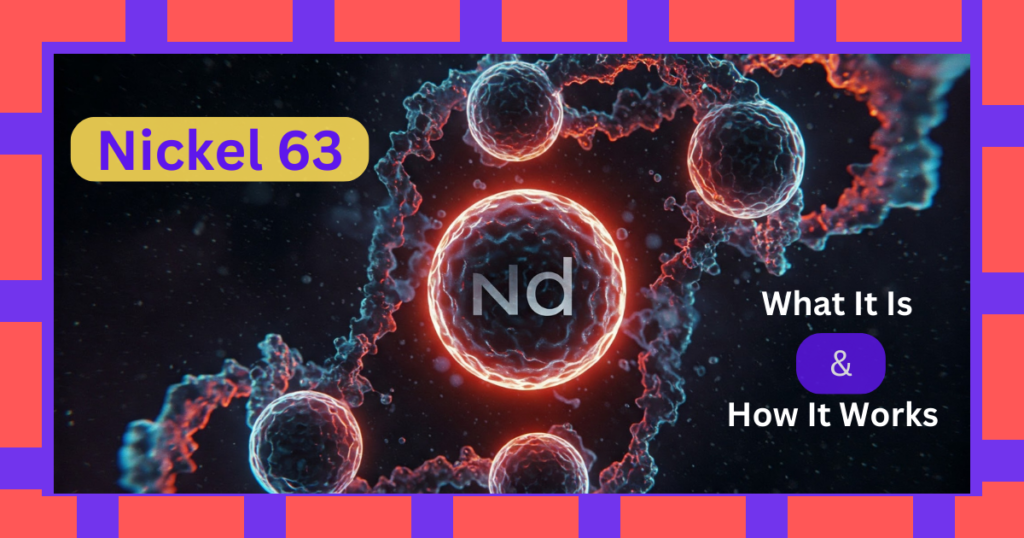Nickel-63 (Ni-63) might not be the first isotope that springs to mind when you think of radioactive isotopes. However, this lesser-known isotope has been quietly making a splash in a variety of scientific and industrial fields. In a decade of blogging, I’ve seen many trends come and go, but Nickel-63’s narrative deserves more attention. In this post, we will look into Nickel-63, its unique features, applications, and why it could be a game changer in the future. So let’s go deeper!

What is Ni-63?
Nickel-63 is a radioactive isotope of nickel that is widely found in the earth’s crust. Unlike its stable sibling, nickel-58, Ni-63 beta decays and emits low-energy beta particles (electrons) as it converts into copper-63. Ni-63 is a relatively long-lived isotope, with a half-life of around 100 years, making it appropriate for long-term uses.
Nickel-63 is appealing because of its low radiation energy. The beta particles it generates are weak, allowing them to be easily protected, lowering the risk of radiation exposure. This makes Ni-63 a safer alternative than other radioactive isotopes, particularly when safety is critical.
Nickel-63 is synthesised in a nuclear reactor through neutron irradiation of nickel-62. Nickel-62 is blasted with neutrons, which the nucleus absorbs and converts to nickel-63. This isotope is then extracted and purified for usage in a variety of applications.
Nickel-63 is highly valued due to its beta decay. During this process, a neutron in the nucleus becomes a proton, which emits an electron (beta particle) and an antineutrino. Nickel-63 is classified as a low-energy beta emitter because to the relatively low energy emitted during its decay, which is approximately 67 keV.
The Future of Nickel-63
As technology advances, so do the possible applications for Ni-63. Researchers are looking into novel ways to utilise its special qualities, particularly in the energy sector. Betavoltaic technology advancements, for example, could result in more efficient and compact batteries, potentially revolutionising industries such as healthcare, aerospace, and consumer electronics.
Nickel-63 is a promising research material for quantum computing. Although the research is still in its early stages, some experts believe that the features of the isotope could help to design more stable and efficient quantum systems.
Uses for Nickel-63
Nickel-63 has been used in a variety of cutting-edge applications due to its unique properties. Here are some notable features:
a. Betavoltaic batteries
As technology advances, so do the possible applications for Ni-63. Researchers are looking into novel ways to utilise its special qualities, particularly in the energy sector. Betavoltaic technology advancements, for example, could result in more efficient and compact batteries, potentially revolutionising industries such as healthcare, aerospace, and consumer electronics.
Ni-63 is a promising research material for quantum computing. Although the research is still in its early stages, some experts believe that the features of the isotope could help to design more stable and efficient quantum systems.
b. Scientific research
Ni-63 is also used in scientific research, particularly investigations of beta decay and nuclear physics. Its steady decay rate and low energy output make it a useful tool for calibrating equipment and performing research.
c. Radiation detection
Ni-63’s low-energy beta particles make it an excellent choice for radiation detectors. These devices have numerous applications, including nuclear power plants, healthcare, and environmental monitoring. Ni-63’s low radiation level allows for precise detection while reducing the potential of harmful exposure.
d. Industrial applications
Ni-63 is used in industrial thickness gauges and other measurement devices. Its ability to generate continuous radiation makes it suitable for assuring precise measurements during production processes.
The Significance of Nickel-63
In a world increasingly focused on sustainability and innovation, Ni-63 offers a unique combination of safety, reliability, and versatility. Its low-energy radiation makes it a safer alternative to other isotopes, while its long half-life ensures that it can be used for long periods of time without degradation.
Moreover, as the demand for long-lasting and reliable energy sources increases, Ni-63-powered betavoltaic batteries could play a key role in meeting this demand. From powering medical devices to enabling space exploration, the possibilities are endless.
Challenges and Considerations
While Ni-63 has great potential, there are challenges to its widespread adoption. One of the main obstacles is the cost and complexity of producing the isotope. The neutron irradiation and purification processes are expensive and require specialized facilities, which may limit its availability.
In addition, the regulatory landscape surrounding radioactive materials can be complex. Ensuring the safe handling, transportation, and disposal of Ni-63 is critical for its successful implementation in a variety of applications.
Concluding remarks
Nickel-63 may not be a household name, but its potential is undeniable. From enhancing the power of life-saving medical devices to enabling groundbreaking scientific research, this remarkable isotope is proving to be a valuable asset in our quest for innovation. As technology evolves, it’s exciting to imagine how Ni-63 could shape the future.
If you’re as curious about Ni-63 as I am, stay tuned for more updates on this incredible isotope. And if you have any questions or thoughts, don’t hesitate to leave a comment below. Let’s keep the discussion going!






